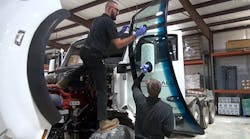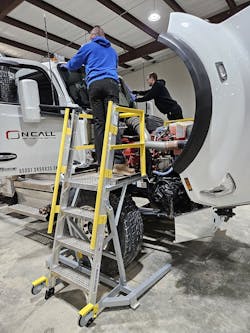The U.S. Department of Transportation (DOT) can fine, suspend, or warn drivers for driving with a cracked windshield that violates federal regulations. The severity of the penalty depends on the extent of the violation and any other violations the driver may have.
Federal regulations
- Cracks cannot be larger than 3/4 inch in diameter
- Cracks cannot be within 3 inches of each other
- Cracks cannot intersect
- Cracks cannot be directly in the driver's view
- The windshield cannot be discolored or damaged above the steering wheel, except for a 2-inch border at the top and a 1-inch border on each side.
State regulations
- Some states may have stricter requirements than the federal regulations
- For example, Pennsylvania does not allow any cracks or chips in the center of the driver's side windshield
Penalties
- Fines can range from a few hundred to thousands of dollars
- The driver and their company may be suspended from operation
- The driver may be sent to jail
- The driver may be issued a written warning
Other consequences
- Driving with a cracked windshield can increase the risk of a collision
- The driver may face lawsuits or be denied insurance claims if the crack contributes to an accident
Broken and cracked windshields are a recurring problem for big rig drivers, and driving a DOT-regulated truck with such damage that may implode on the highway is dangerous. It’s also illegal, according to the Code of Federal Regulations § 393.60. Severe penalties can result, such as fines, license suspension, and even jail time (see sidebar). While cracks, dings, and chips from highway debris are not the driver’s fault, state and federal policies mandate quick and thorough windshield repair or replacement.
Inspecting laminated windshields is an important item of regular truck maintenance. Little cracks or chips that seem harmless can spread quickly from heavy-duty vibrations, extreme temperature shifts, and other stresses. If damage occurs, windshields should be replaced by certified technicians to avoid accidents, injuries, and legal problems.
A clear way to tell if a windshield needs to be repaired is if the driver’s vision is obscured by a crack. The driver’s primary viewing area is defined by the Auto Glass Safety Council as the 12” wide section (centered on the driver’s position), extending from the top to bottom of the wiper blade coverage area.
The AGSC is a not-for-profit organization dedicated to the safe repair and replacement of auto glass, and certifies truck and glass windshield replacement facilities and glass technicians across the U.S. Certification depends on adherence to ANSI/AGSC/ACRSS 005-2022, with best practices in place to avoid accidents during repair and replacement. These can occur during improper installation techniques, use of incorrect adhesives, and incomplete pinchweld preparation.
Technicians must also re-install dash cams and other driver-assist technology, such as mirror camera systems, that must be removed during the windshield replacement.
AGSC President Jacques Navant said certified technicians have been trained to calibrate the technology. “It’s like an optometrist setting a new eyeglass prescription,” he said.
In addition to administrative compliance—making sure that paperwork, materials, and procedures comply with current standards, AGSC stresses the use of proper personal protective equipment, Navant explained.
“Technicians must wear safety glasses, use cut-resistant gloves during preparation and blue nitrile gloves when handling a clean windshield,” he said.
One thing to keep in mind is that commercial vehicle windshields are heavy, weighing 40 to 60 lbs., and even more for the new Amazon delivery vans. Technicians who install them are vulnerable to all kinds of shoulder and back accidents. And trying to heft one up while standing on a tire or flimsy stepladder risks all kinds of injuries from slips or falls.
Ensuring your repair shop is equipped with sturdier safety ladders is an easy way to mitigate technician downtime and possible workman’s compensation claims. This also helps prevent accidental damage during the service repair. These windshields are robust but still glass. A misplaced bootstep or dropped tool can cause a tech to start over with a new windshield.
Jeff Green, president/CEO of LockNClimb, a maker of ergonomic safety ladders, noted this is why one major glass repair company reached out. They were seeing a lot of excessive damage during big truck windshield installs.
“We found a quick solution by simply modifying an existing ladder used for truck engine service,” Green said Technicians now can stand on a stable platform over the truck tires inside safety railings when removing and replacing a truck windshield.”
Green noted these ladders are OSHA 1AA special purpose ANSI rated up to 375 lbs. LockNClimb’s safety ladders are made from 6061-grade industrial quality aluminum composition and include extra-wide comfort treads and slip-resistant material.
About the Author

Banning K. Lary
Banning K. Lary, PhD is a widely published freelance writer and documentarian whose work has been viewed by millions of people around the world. He currently specializes in the subjects of safety, law, science, ergonomics, health and the social sciences.

